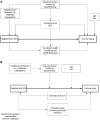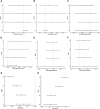The embodiment of the neighborhood socioeconomic environment in the architecture of the immune system
- PMID: 39006475
- PMCID: PMC11244187
- DOI: 10.1093/pnasnexus/pgae253
The embodiment of the neighborhood socioeconomic environment in the architecture of the immune system
Abstract
There is growing recognition of the importance of immune health for understanding the origins of ageing-related disease and decline. Numerous studies have demonstrated consistent associations between the social determinants of health and immunosenescence (i.e. ageing of the immune system). Yet few studies have interrogated the relationship between neighborhood socioeconomic status (nSES) and biologically specific measures of immunosenescence. We used data from the US Health and Retirement Study to measure immunosenescence linked with neighborhood socioeconomic data from the National Neighborhood Data Archive to examine associations between indicators of nSES and immunosenescence. We found associations between both the ratio of terminally differentiated effector memory to naïve (EMRA:Naïve) CD4+ T cells and cytomegalovirus (CMV) immunoglobulin G (IgG) levels and nSES. For the CD4+ EMRA:Naïve ratio, each 1% increase in the neighborhood disadvantage index was associated with a 0.005 standard deviation higher value of the EMRA:Naïve ratio (95% CI: 0.0003, 0.01) indicating that living in a neighborhood that is 10% higher in disadvantage is associated with a 0.05 higher standardized value of the CD4+ EMRA:Naïve ratio. The results were fully attenuated when adjusting for both individual-level SES and race/ethnicity. For CMV IgG antibodies, a 1% increase in neighborhood disadvantage was associated a 0.03 standard deviation higher value of CMV IgG antibodies (β = 0.03; 95% CI: 0.002, 0.03) indicating that living in a neighborhood that is 10% higher in disadvantage is associated with a 0.3 higher standardized value of CMV. This association was attenuated though still statistically significant when controlling for individual-level SES and race/ethnicity. The findings from this study provide compelling initial evidence that large, nonspecific social exposures, such as neighborhood socioeconomic conditions, can become embodied in cellular processes of immune ageing.
© The Author(s) 2024. Published by Oxford University Press on behalf of National Academy of Sciences.
Figures


Similar articles
-
Sociodemographic Differences in Population-Level Immunosenescence in Older Age.medRxiv [Preprint]. 2022 Mar 7:2022.03.05.22271952. doi: 10.1101/2022.03.05.22271952. medRxiv. 2022. Update in: Brain Behav Immun. 2023 Jan;107:361-368. doi: 10.1016/j.bbi.2022.10.019. PMID: 35291293 Free PMC article. Updated. Preprint.
-
DNA Methylation Mediates the Association Between Individual and Neighborhood Social Disadvantage and Cardiovascular Risk Factors.Front Cardiovasc Med. 2022 May 19;9:848768. doi: 10.3389/fcvm.2022.848768. eCollection 2022. Front Cardiovasc Med. 2022. PMID: 35665255 Free PMC article.
-
Relations of optimism and purpose in life to immune markers in aging.J Psychosom Res. 2024 Sep;184:111851. doi: 10.1016/j.jpsychores.2024.111851. Epub 2024 Jun 22. J Psychosom Res. 2024. PMID: 38964200
-
Neighborhood Socioeconomic Status and Stroke Incidence: A Systematic Review.Neurology. 2021 May 11;96(19):897-907. doi: 10.1212/WNL.0000000000011892. Epub 2021 Mar 25. Neurology. 2021. PMID: 33766995 Free PMC article.
-
Potential relationship between cytomegalovirus and immunosenescence: Evidence from observational studies.Rev Med Virol. 2024 Jul;34(4):e2560. doi: 10.1002/rmv.2560. Rev Med Virol. 2024. PMID: 38866595 Review.
Cited by
-
Neighborhood disadvantage and elevated CD14 gene expression among middle-aged adults: Findings from the Midlife in the United States study.Psychoneuroendocrinology. 2025 Jul 16;180:107553. doi: 10.1016/j.psyneuen.2025.107553. Online ahead of print. Psychoneuroendocrinology. 2025. PMID: 40694969
-
Neighborhood-level adversity and inflammation among sexual minority men living with HIV.Health Psychol. 2025 Mar;44(3):188-196. doi: 10.1037/hea0001479. Health Psychol. 2025. PMID: 39992764
-
The aging immune system and all-cause mortality in older americans: differences across sex and race/ethnicity.Immun Ageing. 2025 Jun 21;22(1):25. doi: 10.1186/s12979-025-00521-z. Immun Ageing. 2025. PMID: 40544271 Free PMC article.
-
Minimum Core Data Elements for Evaluation of Thoracic Aortic Disease.JACC Adv. 2025 Jul 17;4(8):102001. doi: 10.1016/j.jacadv.2025.102001. Online ahead of print. JACC Adv. 2025. PMID: 40680492 Free PMC article. Review.
References
-
- Pawelec G, Koch S, Franceschi C, Wikby A. 2006. Human immunosenescence: does it have an infectious component? Ann N Y Acad Sci. 1067(1):56–65. - PubMed
-
- Stassen FR, Vega-Córdova X, Vliegen I, Bruggeman CA. 2006. Immune activation following cytomegalovirus infection: more important than direct viral effects in cardiovascular disease? J Clin Virol. 35(3):349–353. - PubMed
-
- Fülöp T, Larbi A, Witkowski JM. 2019. Human inflammaging. Gerontology. 65(5):495–504. - PubMed
-
- Diez Roux AV, Mair C. 2010. Neighborhoods and health. New York (NY): The New York Academy of Sciences. - PubMed
Grants and funding
LinkOut - more resources
Full Text Sources
Research Materials

